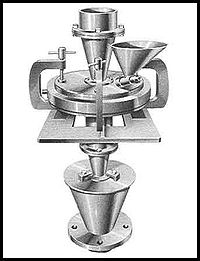Difference between revisions of "Fluid Energy Crusher Mills"
(Created page with "Category:Particle Size Reduction{{Knoppen}} <noinclude><!------------------------------------------------ * READ THIS FIRST * Only edit this page if you can improve the c...") |
PurplePen19 (talk | contribs) |
||
| (One intermediate revision by the same user not shown) | |||
| Line 5: | Line 5: | ||
* Please do not edit the sponsored link on the top right corner. . | * Please do not edit the sponsored link on the top right corner. . | ||
* Please start editing this page after the /noinclude | * Please start editing this page after the /noinclude | ||
* -------------------------------------------------></noinclude> | * -------------------------------------------------></noinclude> | ||
[[File:Fluid Energy Crusher Mills_1.jpg|thumb|200px|right|Fluid Energy Crusher Mills]] | |||
'''Fluid Energy Crusher Mills''' are size-reduction unit depending for its action on collisions between the particles being ground, the energy being supplied by a compressed fluid, (e.g., air or steam) that enters the grinding chamber at high speed. Such mills will give a product of 5 mu m or less; they have been used for the fine grinding of frits, kaolin, zircon, titania, and calcined alumina, but the energy consumed per ton of milled product is high. Materials such as chemicals, pharmaceuticals, antibiotics, etc., which are reduced to low micron sizes, have greatly increased surface area - this effect of increased surface area is very important and is illustrated in industry by improved suspensions; faster and more complete chemical reaction; greater absorption’s - these are only a few of the many and varied results of this increase in particle surface. | |||
==Applications== | |||
*Intimate mixing or coating one material with another while simultaneously grinding and classifying. | |||
*Simultaneous drying and grinding of moist materials by using heated compressed air or superheated steam. | |||
*Reduction of materials suspended in liquids. | |||
*Certain chemical reactions, which have a direct relationship with micron, sized particles, such as oxidation. | |||
==Features== | |||
===Production of fine particles in the lower micron range=== | |||
normally particle with an average size of less than 5 microns are possible. | |||
===Flexibility=== | |||
The operation of the mill may be simply and rapidly altered to suit different products and also obtain varying grades of material from coarse to fine particle sizes. | |||
===Ease of cleaning and sterilizing=== | |||
The mill is designed for efficient and easy cleaning and so is especially suitable for operating on various substances in quick succession. | |||
===Narrow Particle Size Spectrum=== | |||
The range of particle size in the product is very much smaller than with any other type of mill today. | |||
===Temperature Control=== | |||
Absence of moving parts and the cooling effect due to the expansion of compressed fluids leaving the jets, enables heat sensitive products to be easily processed | |||
===Uniformity of Products=== | |||
Controlled operating conditions with intense classifying action produces a high degree of uniformity in the product. | |||
===Variation of Particle Size=== | |||
Product particle size can be controlled and varied. Products and processes are improved and standards of purity increased. | |||
Latest revision as of 07:53, 12 October 2012
Fluid Energy Crusher Mills are size-reduction unit depending for its action on collisions between the particles being ground, the energy being supplied by a compressed fluid, (e.g., air or steam) that enters the grinding chamber at high speed. Such mills will give a product of 5 mu m or less; they have been used for the fine grinding of frits, kaolin, zircon, titania, and calcined alumina, but the energy consumed per ton of milled product is high. Materials such as chemicals, pharmaceuticals, antibiotics, etc., which are reduced to low micron sizes, have greatly increased surface area - this effect of increased surface area is very important and is illustrated in industry by improved suspensions; faster and more complete chemical reaction; greater absorption’s - these are only a few of the many and varied results of this increase in particle surface.
Applications
- Intimate mixing or coating one material with another while simultaneously grinding and classifying.
- Simultaneous drying and grinding of moist materials by using heated compressed air or superheated steam.
- Reduction of materials suspended in liquids.
- Certain chemical reactions, which have a direct relationship with micron, sized particles, such as oxidation.
Features
Production of fine particles in the lower micron range
normally particle with an average size of less than 5 microns are possible.
Flexibility
The operation of the mill may be simply and rapidly altered to suit different products and also obtain varying grades of material from coarse to fine particle sizes.
Ease of cleaning and sterilizing
The mill is designed for efficient and easy cleaning and so is especially suitable for operating on various substances in quick succession.
Narrow Particle Size Spectrum
The range of particle size in the product is very much smaller than with any other type of mill today.
Temperature Control
Absence of moving parts and the cooling effect due to the expansion of compressed fluids leaving the jets, enables heat sensitive products to be easily processed
Uniformity of Products
Controlled operating conditions with intense classifying action produces a high degree of uniformity in the product.
Variation of Particle Size
Product particle size can be controlled and varied. Products and processes are improved and standards of purity increased.
